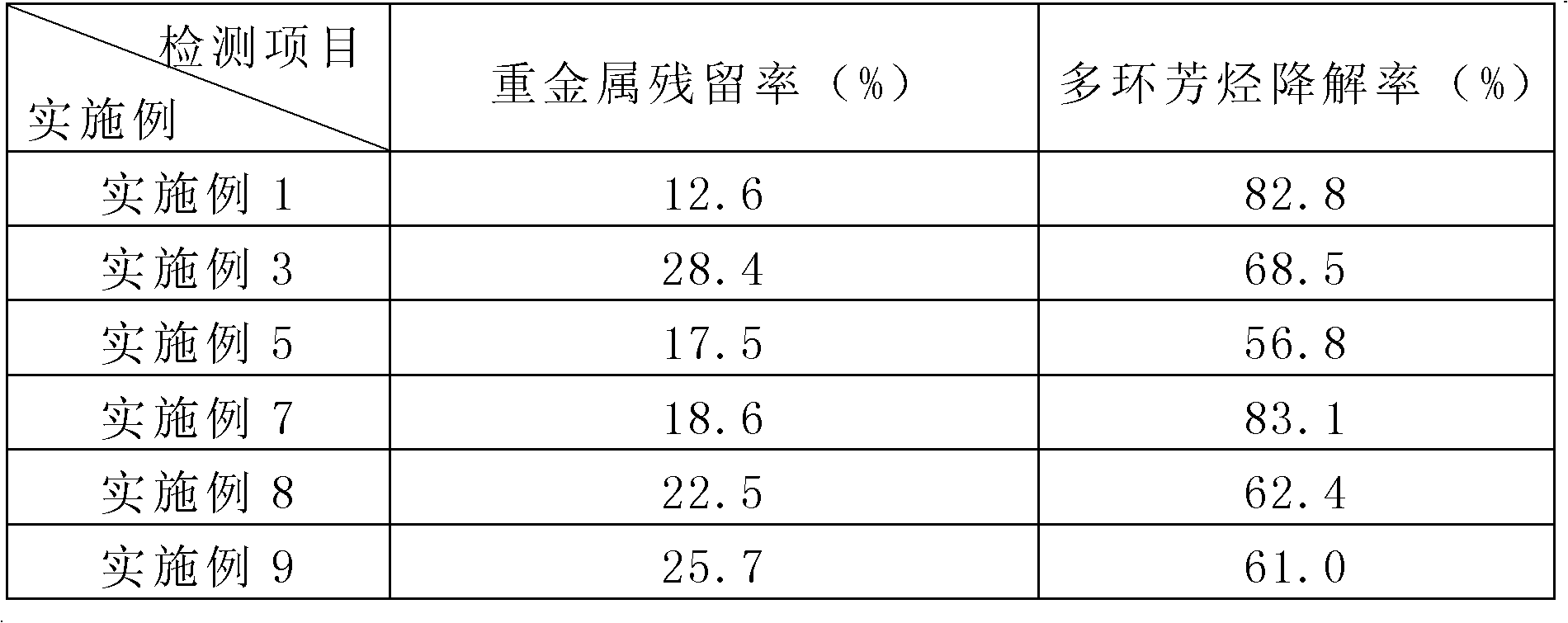New method for combined remediation of compound contaminated soil
A compound pollution and joint restoration technology, applied in the field of compound polluted soil and joint restoration of compound polluted soil, can solve the problems of poor restoration effect of compound pollution polluted soil, unfavorable large-scale application, long restoration period, etc., so as to shorten the restoration time, The effect of low residual rate and simple repair method
- Summary
- Abstract
- Description
- Claims
- Application Information
AI Technical Summary
Problems solved by technology
Method used
Image
Examples
Embodiment 1
[0031] Choose 100g of compound polluted soil polluted by heavy metals and polycyclic aromatic hydrocarbons, then add humic acid and activated sludge, wherein the addition of humic acid is 0.5% of the dry weight of the compound polluted soil, and the addition of activated sludge is the dry weight of soil Then adjust the pH value to 6.5, and then set the volume to 200mL, then put it into a shaker, control the culture temperature at a constant temperature of 35°C, shake the culture and restore it for 48 hours, and then realize the compound polluted soil. Restoration, to get the repaired soil.
[0032] The activated sludge mentioned above is obtained after culturing the sludge in the aeration tank of the sewage treatment plant. The specific cultivating method is:
[0033] The sludge selected from the aeration tank of the sewage treatment plant was added to the culture medium, and the temperature was controlled at 35°C, and the shaker speed was 200r / min, and the shaker culture was ...
Embodiment 2
[0036] Choose 100g of composite polluted soil polluted by heavy metals and polycyclic aromatic hydrocarbons, then add humic acid and activated sludge, wherein the addition of humic acid is 1.0% of the dry weight of the composite contaminated soil, and the addition of activated sludge is soil dry weight Then adjust the pH value to 7.5, then set the volume to 200mL, put it into a shaker, control the culture temperature at a constant temperature of 26°C, and shake the culture for 56 hours to repair the compound polluted soil. Restoration, to get the repaired soil.
[0037] The above-mentioned activated sludge is activated sludge after cultivation, and the specific cultivation method of activated sludge is:
[0038] The sludge selected from the aeration tank of the sewage treatment plant was added to the culture medium, and the temperature was controlled at 30°C, and the shaker speed was 150r / min, and the shaker culture was carried out. During the culture process, BOD 5 :Nitrogen...
Embodiment 3
[0041] Choose 100g of compound polluted soil polluted by heavy metals and polycyclic aromatic hydrocarbons, then add humic acid and activated sludge, wherein the addition of humic acid is 0.1% of the dry weight of the compound polluted soil, and the addition of activated sludge is the dry weight of soil Then adjust the pH value to 8.5, then adjust the volume to 200mL, put it into a shaker, control the culture temperature at a constant temperature of 20°C, and shake the culture for 60 hours to repair the composite polluted soil. , to obtain the repaired soil.
[0042] The above-mentioned activated sludge is activated sludge after cultivation, and the specific cultivation method of activated sludge is:
[0043] The sludge selected from the aeration tank of the sewage treatment plant was added to the culture medium, and the temperature was controlled at 40°C, and the shaker speed was 250r / min, and the shaker culture was carried out. During the culture process, BOD 5 :Nitrogen:Ph...
PUM
 Login to View More
Login to View More Abstract
Description
Claims
Application Information
 Login to View More
Login to View More - R&D
- Intellectual Property
- Life Sciences
- Materials
- Tech Scout
- Unparalleled Data Quality
- Higher Quality Content
- 60% Fewer Hallucinations
Browse by: Latest US Patents, China's latest patents, Technical Efficacy Thesaurus, Application Domain, Technology Topic, Popular Technical Reports.
© 2025 PatSnap. All rights reserved.Legal|Privacy policy|Modern Slavery Act Transparency Statement|Sitemap|About US| Contact US: help@patsnap.com


